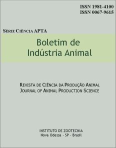Basic cation saturation ratio as liming criterion for three tropical forage legumes
Keywords:
liming, basic cation saturation ratio, neonotonia wightii, matrotyloma axillare, stylosanthes guianensis, forage legumesAbstract
Three tropical forage legumes under increasing basic cation saturation ratio (BCSR) were grown in greenhouse in order to be determined the ratio on which best response is reached on dry matter yield basis. The four BCSR were: 10, 30, 50 and 70%, provided by an addition of calcium and magnesium oxides equivalent to 0; 1.2; 2.4 and 3.6 t/ha of lime, with five replications. A complete randomized design was used. Soil analysis at the 20th. day showed in increase in pH and BCSR values and a decrease in Al3 values due to liming. Maximum dry matter yields were obtained with 57% for perennial soybean (Neonotonia wightii Lakey var. Tinaroo) and 35% for stylo (Srylosanthes guianensis Sw. cv. Bandeirante). Maximum yield was not achieved by macrotiloma(Macrotyloma axillare Verdc.) cv. Guatá which showed linear increases up to the higher BCSR used. The increases in basic cation saturation ratios resulted in an linear increase in root nodule numbers by perennial soybean and an increase in nodule weight up to the 49% ratio. For macrotiloma, nodule weight and numbers increased linearly.Downloads
Downloads
Published
Issue
Section
License
Os autores não serão remunerados pela publicação de trabalhos, pois devem abrir mão de seus direitos autorais em favor deste periódico. Por outro lado, os autores ficam autorizados a publicar seus artigos, simultaneamente, em repositórios da instituição de sua origem, desde que citada a fonte da publicação original seja Boletim de Indústria Animal. A revista se reserva o direito de efetuar, nos originais, alterações de ordem normativa, ortográfica e gramatical, com vistas a manter o padrão culto da língua e a credibilidade do veículo. Respeitará, no entanto, o estilo de escrever dos autores. Alterações, correções ou sugestões de ordem conceitual serão encaminhadas aos autores, quando necessário. Nesses casos, os artigos, depois de adequados, deverão ser submetidos a nova apreciação. As opiniões emitidas pelos autores dos artigos são de sua exclusiva responsabilidade. Todo o conteúdo deste periódico, exceto onde está identificado, está licenciado sob a Licença Creative Commons Attribution (CC-BY-NC). A condição BY implica que os licenciados podem copiar, distribuir, exibir e executar a obra e fazer trabalhos derivados com base em que só se dão o autor ou licenciante os créditos na forma especificada por estes. A cláusula NC significa que os licenciados podem copiar, distribuir, exibir e executar a obra e fazer trabalhos derivados com base apenas para fins não comerciais.













